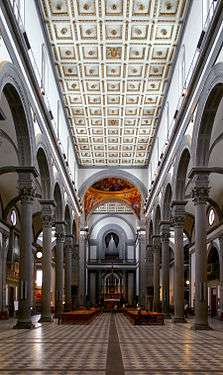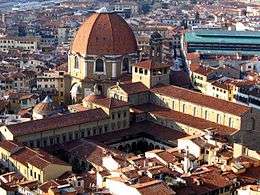San Lorenzo, Florence
The Basilica di San Lorenzo (Basilica of St Lawrence) is one of the largest churches of Florence, Italy, situated at the centre of the city’s main market district, and the burial place of all the principal members of the Medici family from Cosimo il Vecchio to Cosimo III. It is one of several churches that claim to be the oldest in Florence, having been consecrated in 393,[1] at which time it stood outside the city walls. For three hundred years it was the city's cathedral before the official seat of the bishop was transferred to Santa Reparata.
| Basilica di San Lorenzo | |
|---|---|
| Basilica of Saint Lawrence | |
 Basilica di San Lorenzo Location in Florence | |
| 43°46′29.7″N 11°15′13.9″E | |
| Location | Florence, Tuscany |
| Country | Italy |
| Denomination | Roman Catholic |
| History | |
| Status | Minor basilica |
| Dedication | Saint Lawrence |
| Consecrated | 393 |
| Architecture | |
| Architect(s) | Filippo Brunelleschi, Michelangelo |
| Architectural type | Church |
| Style | Renaissance |
| Groundbreaking | 15th century |
| Completed | 1470 |
| Administration | |
| Archdiocese | Archdiocese of Florence |

San Lorenzo was the parish church of the Medici family. In 1419, Giovanni di Bicci de' Medici offered to finance a new church to replace the 11th-century Romanesque rebuilding. Filippo Brunelleschi, the leading Renaissance architect of the first half of the 15th century, was commissioned to design it, but the building, with alterations, was not completed until after his death. The church is part of a larger monastic complex that contains other important architectural and artistic works: the Old Sacristy by Brunelleschi, with interior decoration and sculpture by Donatello; the Laurentian Library by Michelangelo; the New Sacristy based on Michelangelo's designs; and the Medici Chapels by Matteo Nigetti.
History
The Basilica of San Lorenzo is considered a milestone in the development of Renaissance architecture. The basilca has a complicated building history. The project was begun around 1419, under direction of Filippo Brunelleschi, Lack of funding slowed the construction and forced changes to the original design. By the early 1440s, only the sacristy (now called the Old Sacristy) had been worked on as it was being paid for by the Medici. In 1442, the Medici stepped in to take over financial responsibility of the church as well. Brunelleschi died in 1446, however, and the job was handed either to Antonio Manetti or to Michelozzo; scholars are not certain. Though the building was “completed” in 1459 in time for a visit to Florence by Pius II, the chapels along the right-hand aisles were still being built in the 1480s and 1490s.
By the time the building was done, aspects of its layout and detailing no longer corresponded to the original plan. The principal difference is that Brunelleschi had envisioned the chapels along the side aisles to be deeper, and to be much like the chapels in the transept, the only part of the building that is known to have been completed to Brunelleschi's design.[2]
The building in Renaissance architecture

The Basilica of San Lorenzo demonstrates many innovative features of the developing style of Renaissance Architecture.
- a simple mathematical proportional relationship using the sqare aisle bay as a module and the nave bays in a 2x1 ratio.
- the use of an integrated system of column, arches, and entablatures, based on Roman Classical models
- the use of Classical proportions for the height of the columns
- a clear relationship between column and pilaster, the latter meant to be read as a type of embedded pier.
- the use of spherical segments in the vaults of the side aisles.
- the articulation of the structure in pietra serena (Italian: “dark stone”).

The design of San Lorenzo has at times met with criticism, particularly when compared with Santo Spirito, also in Florence and which is considered to have been constructed more or less in conformity with Brunelleschi's ideas, even though he died before most of it was built. By the 16th century, Giorgio Vasari commented that the columns along the nave should have been elevated on plinths.[3] The steps along the aisles, supporting the pilasters, have also been considered to deviate from Classical ideals.
Outer and inner façades
The Medici Pope Leo X gave Michelangelo the commission to design a façade in white Carrara marble in 1518. Michelangelo made a wooden model, which shows how he adjusted the classical proportions of the facade, drawn to scale, after the ideal proportions of the human body, to the greater height of the nave. The work remained unbuilt. Michelangelo did, however, design and build the internal facade, seen from the nave looking back toward the entrances. It comprises three doors between two pilasters with garlands of oak and laurel and a balcony on two Corinthian columns.
In recent years, the association of “Friends of the Elettrice Palatina” and the Comune of Florence re-visited the question of completing the outer facade according to Michelangelo's designs. To assist with the public debate, a computerized reconstruction was projected onto the plain brick facade in February 2007. As yet, no decision has been made on the project.[4]
The campanile dates from 1740.
Old Sacristy
Opening off the north transept is the square, domed space, the Sagrestia Vecchia, or Old Sacristy, that was designed by Brunelleschi and that is the oldest part of the present church and the only part completed in Brunelleschi's lifetime; it contains the tombs of several members of the Medici family. It was composed of a sphere on top of a cube; the cube acting as the human world and the sphere the heavens.
New Sacristy
Opposite the Old Sacristy in the south transept is the Sagrestia Nuova (New Sacristy), begun in 1520 by Michelangelo, who also designed the Medici tombs within. The new sacristy was composed of three registers, the topmost topped by a coffered pendentive dome. The articulation of the interior walls can be described as early examples of Renaissance Mannerism (see Michelangelo's Ricetto in the Laurentian Library). The combination of pietra serena pilasters on the lower register is carried through to the second; however, in Mannerist fashion, architectural elements 'seem impossible,' creating suspense and tension that is evident in this example. Michelangelo's sculptural elements, to be used on the tombs themselves, were left undone. A difficult person to work with, Michelangelo refused to direct the completion of the new sacristy.
In a statement in the Michelangelo’s biography published in 1553 by his disciple, Ascanio Condivi, and largely based on Michelangelo own recollections, Condivi gives the following description: "The statues are four in number, placed in a sacristy . . . the sarcophagi are placed before the side walls, and on the lids of each there recline two big figures, larger than life, to wit, a man and a woman; they signify Day and Night and, in conjunction, Time which devours all things… And in order to signify Time he planned to make a mouse, having left a bit of marble upon the work (which [plan] he subsequently did not carry out because he was prevented by circumstances), because this little animal ceaselessly gnaws and consumes just as time devours everything”.[5] [6] A concealed corridor with drawings on the walls by Michelangelo was discovered under the New Sacristy in 1976.[7][8]
Cappelle Medicee

The most celebrated and grandest part of San Lorenzo are the Cappelle Medicee (Medici Chapels) in the apse. The Medici were still paying for it when the last member of the family, Anna Maria Luisa de' Medici, died in 1743. Almost fifty lesser members of the family are buried in the crypt. The final design (1603–1604) was by Bernardo Buontalenti, based on models of Alessandro Pieroni and Matteo Nigetti. Above is the Cappella dei Principi (Chapel of the Princes), a great but awkwardly domed octagonal hall where the grand dukes themselves are buried. The style shows Mannerist eccentricities in its unusual shape, broken cornices, and asymmetrically sized windows. In the interior, the ambitious decoration with colored marbles overwhelms the attempts at novel design (Wittkower, R. p. 126). At its centre was supposed to be the Holy Sepulchre itself, although attempts to buy and then steal it from Jerusalem failed.
Cappella Corbelli
The Corbelli chapel, in the southern transept, contains a monument by the sculptor Giovanni Dupre to the wife of Count Moltke-Hwitfeld, formerly Danish ambassador to the Court of Naples.[9]
Works of art

- Bronzino - The Martyrdom of St Lawrence, fresco, north aisle
- Desiderio da Settignano - Pala del Sacramento, tabernacle, south aisle
- Donatello - two pulpits, (his last works); bronze and marble, nave
- Donatello - frieze, reliefs, tondi and bronze doors, Sagrestia Vecchia
- Antonio del Pollaiuolo - Crucifix, wood, south transept chapel
- Fra Filippo Lippi - Annunciation, altarpiece, north transept chapel
- Rosso Fiorentino - Marriage of the Virgin, oil on canvas, in one of the south aisle chapels
- Verrocchio - Tomb of Giovanni and Piero de Medici, bronze, marble, Sagrestia Vecchia
Funerary monuments
- Bernardo Cennini (goldsmith and printer) (south transept)
- Donatello (north transept)
- Francesco Landini (south aisle)
- Niccolò Martelli (north transept)
- Cosimo de' Medici (in front of the high altar)
- Cosimo I de' Medici (Cappella dei Principi)
- Cosimo II de' Medici (Cappella dei Principi)
- Cosimo III de' Medici (Cappella dei Principi)
- Ferdinando I de' Medici (Cappella dei Principi)
- Ferdinando II de' Medici (Cappella dei Principi)
- Ferdinando III de' Medici (crypt)
- Francesco I de' Medici (Cappella dei Principi)
- Giovanni di Bicci de' Medici (Sagrestia Vecchia)
- Giovanni di Cosimo de' Medici (Sagrestia Vecchia)
- Giuliano di Lorenzo de' Medici (Sagrestia Nuova)
- Giuliano di Piero de' Medici (Sagrestia Nuova)
- Lorenzo I de' Medici (Sagrestia Nuova)
- Lorenzo II de' Medici (Sagrestia Nuova)
- Piero di Cosimo de' Medici (Sagrestia Vecchia)
- Nicolas Steno
See also
References
Notes
- Haegen, Anne Mueller von der; Strasser, Ruth F. (2013). "San Lorenzo". Art & Architecture: Tuscany. Potsdam: H.F.Ullmann Publishing. p. 240. ISBN 978-3-8480-0321-1.
- Eugenio Battisti. Filippo Brunelleschi: The Complete Work. (New York: Rizzoli, 1981)
- See also: Howard Saalman. Filippo Brunelleschi: The Buildings. (London: Zwemmer, 1993).
- Battisti. Ibid.
- The debate to finish the facade of San Lorenzo | Arttrav.com
- Panofsky, Erwin (1964). "The Mouse That Michelangelo Failed to Carve" (PDF) (Essays In Memory of Karl Lehmann ed.). N.Y.: Institute of Fine Arts, New York University: 242–255. Cite journal requires
|journal=(help) - Barenboim P. D. / Peter Barenboim (2017). "The Mouse that Michelangelo Did Carve in the Medici Chapel: An Oriental Comment to the Famous Article of Erwin Panofsky". Cite journal requires
|journal=(help)CS1 maint: multiple names: authors list (link) - Peter Barenboim, Sergey Shiyan, Michelangelo: Mysteries of Medici Chapel, SLOVO, Moscow, 2006. ISBN 5-85050-825-2
- Peter Barenboim, Michelangelo Drawings: Key to the Medici Chapel Interpretation, Moscow, Letny Sad, 2006, ISBN 5-98856-016-4
- Walks in Florence and Its Environs, Volume 1, by Susan Horner, 1884, page 116.
Further reading
- Barenboim, Peter (with Heath, Arthur). 500 years of the New Sacristy: Michelangelo in the Medici Chapel, LOOM, Moscow, 2019. ISBN 978-5-906072-42-9
- Peter Barenboim, Michelangelo Drawings: Key to the Medici Chapel Interpretation, Moscow, Letny Sad, 2006. ISBN 5-98856-016-4
- Peter Barenboim, Sergey Shiyan, Michelangelo: Mysteries of Medici Chapel, SLOVO, Moscow, 2006. ISBN 5-85050-825-2
- Edith Balas, "Michelangelo's Medici Chapel: a new Interpretation", Philadelphia, 1995
- James Beck, Antonio Paolucci, Bruno Santi, "Michelangelo. The Medici Chapel", London, New York, 2000
- Brock, Maurice (2002). Bronzino. Paris: Flammarion. pp. 20–24.
- Luchinat, Cristina A. (2002). The Medici, Michelangelo & the Art of Late Renaissance Florence. New Haven and London: Yale University Publishing. pp. 13–14.
- Pilliod, Elizabeth (1992). "Bronzino's Household". The Burlington Magazine (134): 92–100.
- Saalman, Howard (1985). "The New Sacristy of San Lorenzo Before Michelangelo". The Art Bulletin. Colorado Springs: The Art Bulletin, Vol. 67, No. 2. 67 (2): 199–228. doi:10.2307/3050908. JSTOR 3050908.
- Vasari, Giorgio. Filippo Di Ser Brunelesco: Giorgio Vasari's Lives of the Artists
- "Church of San Lorenzo." Insecula. 31 January 2007
- Wittkower, Rudolf (1993). Pelican History of Art (ed.). Art and Architecture Italy, 1600-1750. 1980. Penguin Books Ltd. p. 126.
- Touring Club Italiano, Guida d'Italia: Firenze e dintorni
External links
| Wikimedia Commons has media related to San Lorenzo (Florence). |
